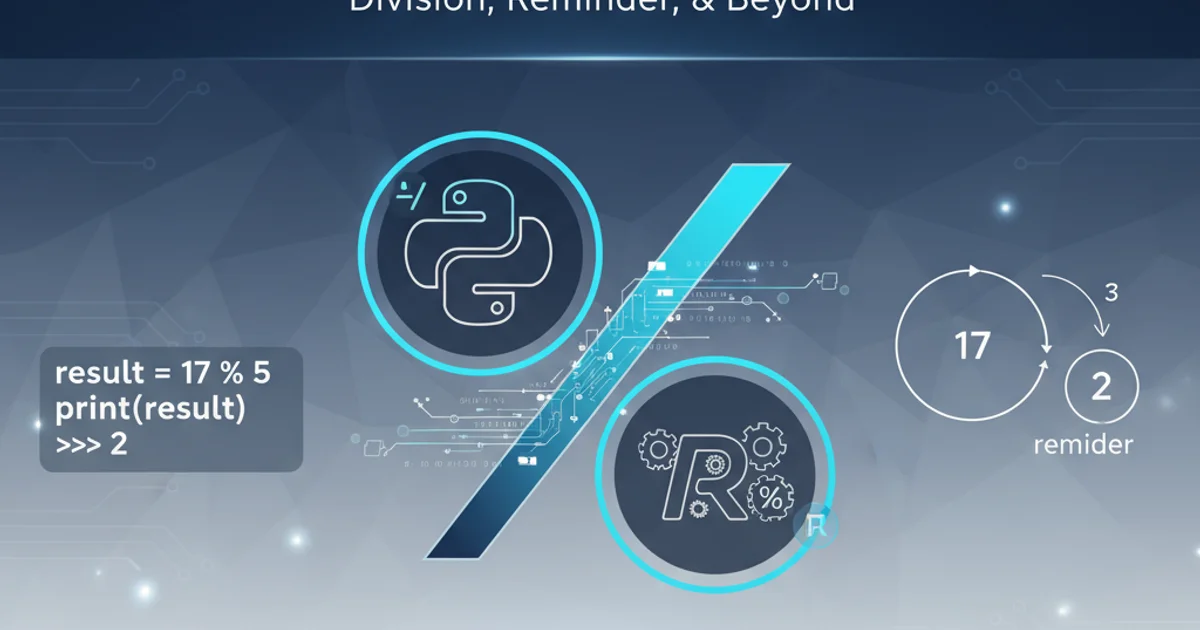What does the percentage sign mean in Python
Categories:
Understanding the Percentage Sign (%) in Python: Modulo Operator Explained

Explore the versatile percentage sign (%) in Python, primarily known as the modulo operator, and learn how it's used for remainder calculations, string formatting, and more.
In Python, the percentage sign (%) is a surprisingly versatile operator that serves multiple purposes. While its most common and fundamental use is as the modulo operator, it also historically played a significant role in string formatting. Understanding its different applications is crucial for writing effective and idiomatic Python code. This article will delve into its primary functions, providing clear explanations and practical examples.
The Modulo Operator: Finding the Remainder
The primary function of the percentage sign in Python is the modulo operator. It returns the remainder of a division operation. This is incredibly useful in various programming scenarios, such as determining if a number is even or odd, cycling through a list, or implementing custom hashing functions. Unlike standard division which gives a quotient, modulo focuses solely on what's left over after dividing one number by another.
# Basic modulo operations
print(10 % 3) # Output: 1 (10 divided by 3 is 3 with a remainder of 1)
print(15 % 4) # Output: 3 (15 divided by 4 is 3 with a remainder of 3)
print(20 % 5) # Output: 0 (20 divided by 5 is 4 with a remainder of 0)
# Checking for even/odd numbers
num = 7
if num % 2 == 0:
print(f"{num} is even")
else:
print(f"{num} is odd") # Output: 7 is odd
Examples of the modulo operator in action.
5 % -3 results in -1, while -5 % 3 results in 1.Modulo for String Formatting (Legacy Method)
Historically, the percentage sign was the primary method for string formatting in Python, often referred to as "printf-style" formatting, similar to C. While newer, more flexible methods like f-strings and the str.format() method are now preferred, you might still encounter % formatting in older codebases. It allows you to embed values into a string using format specifiers like %s for strings, %d for integers, and %f for floating-point numbers.
name = "Alice"
age = 30
height = 5.9
# Using % for string formatting
message = "Hello, my name is %s and I am %d years old. I am %.1f feet tall." % (name, age, height)
print(message)
# Output: Hello, my name is Alice and I am 30 years old. I am 5.9 feet tall.
# Formatting with a dictionary (named placeholders)
data = {'item': 'laptop', 'price': 1200.50}
formatted_string = "The %(item)s costs $%(price).2f." % data
print(formatted_string)
# Output: The laptop costs $1200.50.
Examples of legacy string formatting using the percentage sign.
% formatting still works, it is generally recommended to use f-strings (Python 3.6+) or str.format() for new code due to their improved readability, flexibility, and safety.When to Use Modulo: Practical Applications
The modulo operator is a fundamental tool in a programmer's arsenal. Here are some common scenarios where it proves invaluable:
- Cyclic Operations: When you need to cycle through a sequence or array, modulo helps wrap around to the beginning. For example, accessing elements in a circular buffer.
- Time Calculations: Converting seconds into minutes and remaining seconds, or hours into days and remaining hours.
- Hashing: Many hashing algorithms use modulo to map a large range of input values to a smaller, fixed range of hash values.
- Number Theory: Determining divisibility, finding prime numbers, or implementing cryptographic algorithms often relies on modulo arithmetic.
- Pagination: Calculating which page a record belongs to or how many items are left on the last page.
flowchart TD
A[Input Number] --> B{Is Number % 2 == 0?}
B -- Yes --> C[Number is Even]
B -- No --> D[Number is Odd]
C --> E[End]
D --> E[End]Flowchart illustrating how the modulo operator determines if a number is even or odd.
In summary, the percentage sign in Python is primarily the modulo operator, providing the remainder of a division. While its use for string formatting is largely superseded by newer methods, understanding its historical context and its core function as a mathematical operator is essential for any Python developer.